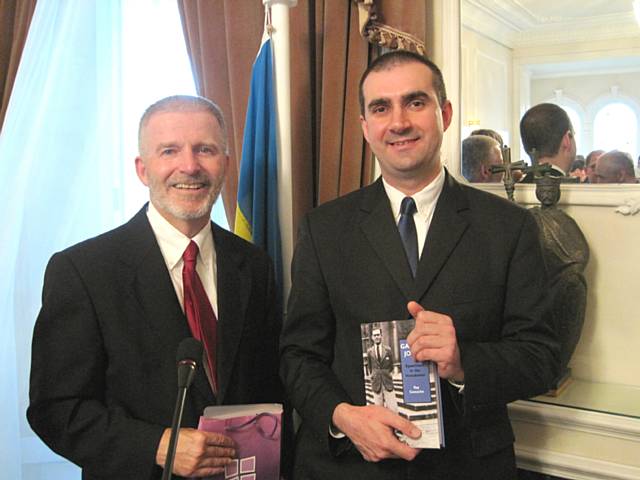
IN July 2013, Author Dr Ray Gamache and Taras Melnyk, from the Rochdale Ukrainian Community at the book launch in London. Northern Voices now publishes this as many Ukrainians remember the man-made famine of 1933 and beyond.
The Rochdale branch of this organisation was the first group within the UK to publicise it and had previously pushed the council to place a memorial remembering the disaster outside Rochdale Town Hall.
The book titled ‘Eyewitness to the Holodomor’ is written by Ray Gamache and talks about the discoveries made by former Foreign Adviser Gareth Jones.
The book is the first academic work on Gareth Jones. It informs the reader how Gareth was the first person to bring the famine to the attention of the general population and the first to blame the Soviet Union for the part they played in causing the famine.
At one time the rural population of Ukraine was dying at a rate of 25,000 per day. The land which was known as the breadbasket of Europe had been ravaged by a man made famine of unprecedented scale.
It is hoped the release of this book and the publicity it’s getting from the Ukrainians currently based the United Kingdom will help in the aim of trying to get the UK government to recognise this as genocide.
It’s only recently that countries such as the United States and Canada have actually recognised it as genocide. This has recently been discussed by MPs in the United Kingdom and it’s hoped they will follow the example set by the USA and Canada.
Many people within Ukrainian communities had thanked Gareth Jones for speaking out against the famine when many of their family members had no voice and simply couldn’t speak out.
Taras Melnyk, a member of the Holodomor committee and part of the Ukrainian community within Rochdale, said: “This famine has always been close to the people of Rochdale, we hope the book raises awareness of the tragedy.
'The fact that it’s being discussed in the House of Parliament is a positive step for certain.'
The Holodomor (Ukrainian: Голодомор, "Extermination by hunger" or "Hunger-extermination";[2] derived from 'Морити голодом', "Starving someone" [3]) was a man-made famine in the Ukrainian SSR and adjacent Cossack territories in 1932 and 1933. During the famine, which is also known as the "Terror-Famine in Ukraine" and "Famine-Genocide in Ukraine",[4][5][6] millions of Ukrainians and Cossacks died of starvation in a peacetime catastrophe unprecedented in the history of Ukraine.[7]
The estimates of the death toll by scholars varied greatly. Recent research has narrowed the estimates to between 1.8[8] and 5[9] million, with modern consensus for a likely total of 3–3.5 million.[10] According to the decision of Kyiv Appellation Court, the demographic losses due to the famine amounted to 10 million, with 3.9 million famine deaths, and a 6.1 million birth deficit.[11]
Scholars disagree on the relative importance of natural factors and bad economic policies as causes of the famine and the degree to which the destruction of the Ukrainian peasantry was premeditated on the part of Joseph Stalin.[7][12][13][14] Some scholars and politicians using the word Holodomor emphasize the man-made aspects of the famine, arguing that it was genocide; some consider the resultant loss of life comparable to the Holocaust.[15] They argue that the Soviet policies were an attack on the rise of Ukrainian nationalism and therefore fall under the legal definition of genocide.[16][17][18][19][20] Other scholars argue that the Holodomor was a consequence of the economic problems associated with radical economic changes implemented during the period of liquidation of private property and Soviet industrialization

No comments:
Post a Comment